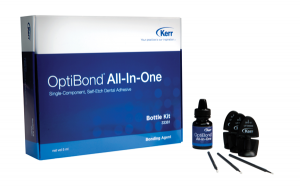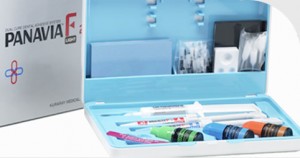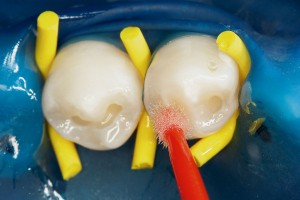Dentine Bonding Agents:
These are agents used to aid the adhesion of restorative materials to dentine.
These are dental materials that adhere to tooth structure.
Theoretically, these agents allow more conservative approach to cavity preparation since reliance on a traditional restorative feature is reduced (Grooves and Slots)
Ideal requirements of dentin bonding agents:
High bond strength to dentin .
Provide bond strength to dentin similar to that of enamel.
Biocompatibility to dental tissue including the pulp.
Minimize microleakage at the margins of the restorations.
Prevent recurrent caries and marginal staining.
Easy to use and minimally technique sensitive.
Good shelf life.
Be compatible with a wide range of resins.
Non toxic and non sensitizing to the operators or patients.
Bonding agents should seal the tooth surfaces from oral
fluids.
USES:
1. Used for bonding of directly/ indirectly placed resin.
2. Bonding of ceramic restoration
3. Bonding of amalgam to tooth structure
4. Rx of sensitive cervical dentine.
5. Re-attachment of fractures tooth fragment
6. As a pulp capping agent
7. Adhesive luting for conservative bridge work.
8. Repair of ceramic and metal ceramic restorations, to
give life-like appearance to the finished restoration.
9. To prevent micro-leakage
10. To increased bond strength
11. To prevent post-operative sensitivity in class II
restorations
12. Prevents fracture of tooth by providing strength
Composition of dentin bonding agents
Etchants
Primers
Adhesives
Initiators and accelerators
Fillers
Other ingredients.
Ideally DBA should contain hydrophobic and hydrophilic components.
Hydrophilic: To displace water and thereby wet the surface permitting it to penetrate porosity or to react with organic and inorganic components
Hydrophobic – to react with restorative material
Hydrophilic part is designed with an active group, hopefully to bond either with Ca in hydroxyapatite crystals or with collagen of organic content of dentine.
Hydrophobic part would bond to restorative resin.
Conditioning dentine:
Definition: Any alteration of the dentine done after cavity preparation usually termed as conditioning the dentine
Objective:
To create a surface capable of micro-mechanical and possiblychemical bonding to a DBA
Effects:
Physical
1. Increased or decreased in thickness and morphology of smear layer.
2. Change in shape of dentinal tubule.
Conditioning of the dentin
Chemicals
Acids
Calcium chelators
Thermal:
Lasers
Mechanical:
Abrasion
The various acid etchants used are:
Organic
Maliec acid
Tartaric acid
Citric acid
EDTA
Acidic monomers
Polymeric
Polyacrylic acid
Mineral acids
Hydrochloric acid
Nitric acid
Hydrofluoric acid
Conditioners
Free flowing/ gel etchants
Chemical
Decalcification of organic portion.
Modification of fraction of organic matter.
Can be done by chemicals, Thermal and mechanical modification
Mechanical- by micro-abrasion
Thermal -by lasers.
Primers:
They are defined as chemicals capable of improving the wetability of adherence or capable of being incorporated into the surface of a substrate
Advantages:
Increased surface wettability
Increased surface energy
Stabilises collagen fibres
Enhances monomer penetration
Primers – bi-functional molecule containing hydrophobic and hydrophillic
Hydrophobic affinity for resin
Hydrophilic affinity for tooth.
Available in 3 forms:
Primer alone
Primer with conditioner – self etched primers
Primer + resin
Ex- HEMA (hydroxyethyl methacrylate)
Biphenyl dimethacrylate
Glycero Phosphoric acid.
Primers
Surface tension less than the surface free energy of the acid etched dentin.
Amphiphilic bifunctional molecules.
Monomers used are
HEMA
NPG-GMA
PMDM
BPDM
PENTA
Acidic primers containing carboxylic acid groups are used in self etching bonding agents.
The solvents used in primers
Acetone
Ethanol/ water
Primarily water.
In some primers solvent levels can be as high as 90%.
A few fourth and fifth generation bonding agents are solvent free.
Acetone – H2O
Eg: Tenure- quick
Acetone- ethanol
Eg: All bond 2 ( Bisco)
Ethanol- water
Eg: Gluma comfort bond
Scotchbond
Classification of dentin bonding agents:
According to generation.
According to adhesion strategy( No of clinical applications).
According to chemical composition.
According to treatment of smear layer.
According to Ph.
According to bond strength
According to mode of curing
According to type of solvent.
First generation adhesives:
Those developed prior to 1980.
Example – Cervident
Second generation adhesives:
These enjoyed commercial success in the early part of the decade.
Example: Scothbond, Dentin adheist, Bondlite, Primer universal bond.
These are basically esters of chlorphosphate and they needed presence of smear layer for their adhesiveness
Third Generation adhesives:
These agents require removal or modification of smear layer and these were chemically more complex.
One basic thing was dentine conditioning with weak acids like EDTA or 2.5% nitric acid in combination with ferric oxalate.
This chelation step was followed by sequential Rx of N.P.G.G.M.A
Example: Tennure solution, clearfil, Linear Bond, Glumma (EDTA) scotchbond (maleic acid and HEMA)
Micromechanical means of adhesion.
Disadvantages: Technique sensitive and time consuming
Conditioner EDTA 17%, primer 35% HEMA, 5% gluteraldehyde
Resin – BISGMA and TEGTMA
Fourth generation adhesives:
It contains primer and resin
It is more convenient than 3rd generation DBA
The primer and sealers are NPG-GMA and bisphenyl dimethacrylate and unfilled resin adhesive. (40% BISGMA, 30% UDMA, 30% HEMA)
This system bonds composite not only to dentine but to most dental related surfaces like enamel casting alloys, amalgam, porcelain and composite
Trade name – All bond 1×2, Amalga Bond plus and linear bond 2
Hybrid Layer:
Composed of primer + Dentine +
Smear layer Serves as cushioning
network
Examples:
Agents used in this generation
All bond 2( Bisco Dental)
Amalgam- bond( Parkell)
Clearfil Liner Bond( Kuraray)
Imperva Bond( Shofu Dental)
Optibond( Kerr)
Scotch bond multipurpose( 3M Dental)
Fifth generation adhesives:
One bottle bond
Serves as both priming and bonding agent
Contains PENTA (dipenta erythritol penta acrylate monophosphate)
The hydrophillic groups of PENTA flow over the dentine surface and wet it thoroughly
It contains acetone to remove resin
Ex: Prime and Bond T.M. 2.00 and 2.1
Disadvantages: Prepared cavity needs to be etched well with 37% phosphoric acid.
Sixth Generation adhesives:
Self etchant adhesives
Latest one bottle bond
Contains self etchant (acid etching solution)
Contains nano fillers which do not scatter light.
(Contains hydrophillic monomers like phenyl P and 50% HEMA)
They provide radio opacity without hampering the esthetics of materials. Hence the smear layer is modified and it is called HYBRID LAYER
It is effective in wet bonding
It also contains comfort application of these bonding agents in 2-3 layers
Seventh Generation Bonding systems:
They are truly all in one self etch adhesives that require no mixing.
Eg:
I bond( Heraeus Kulzer).
G Bond( GC America).


